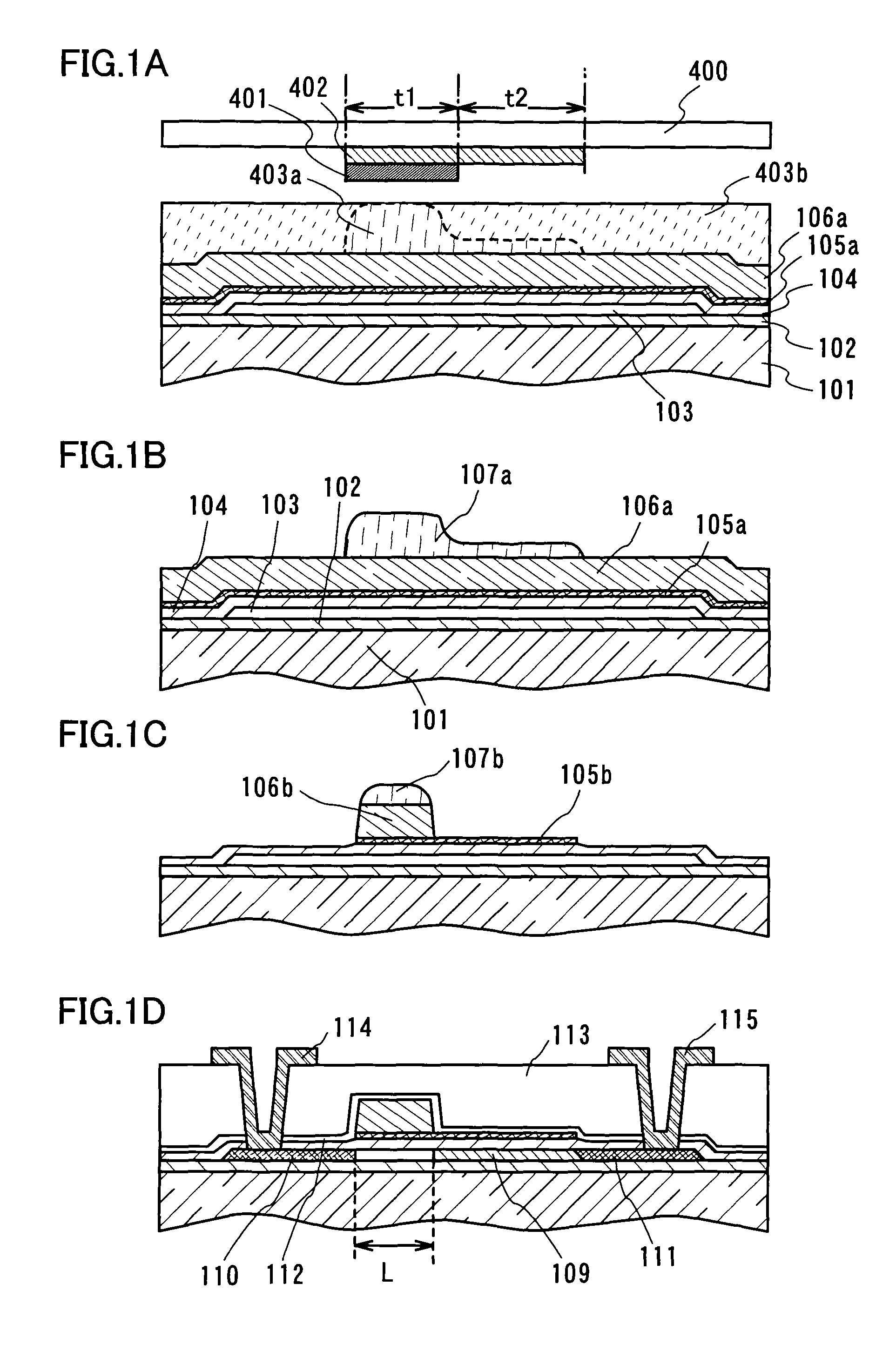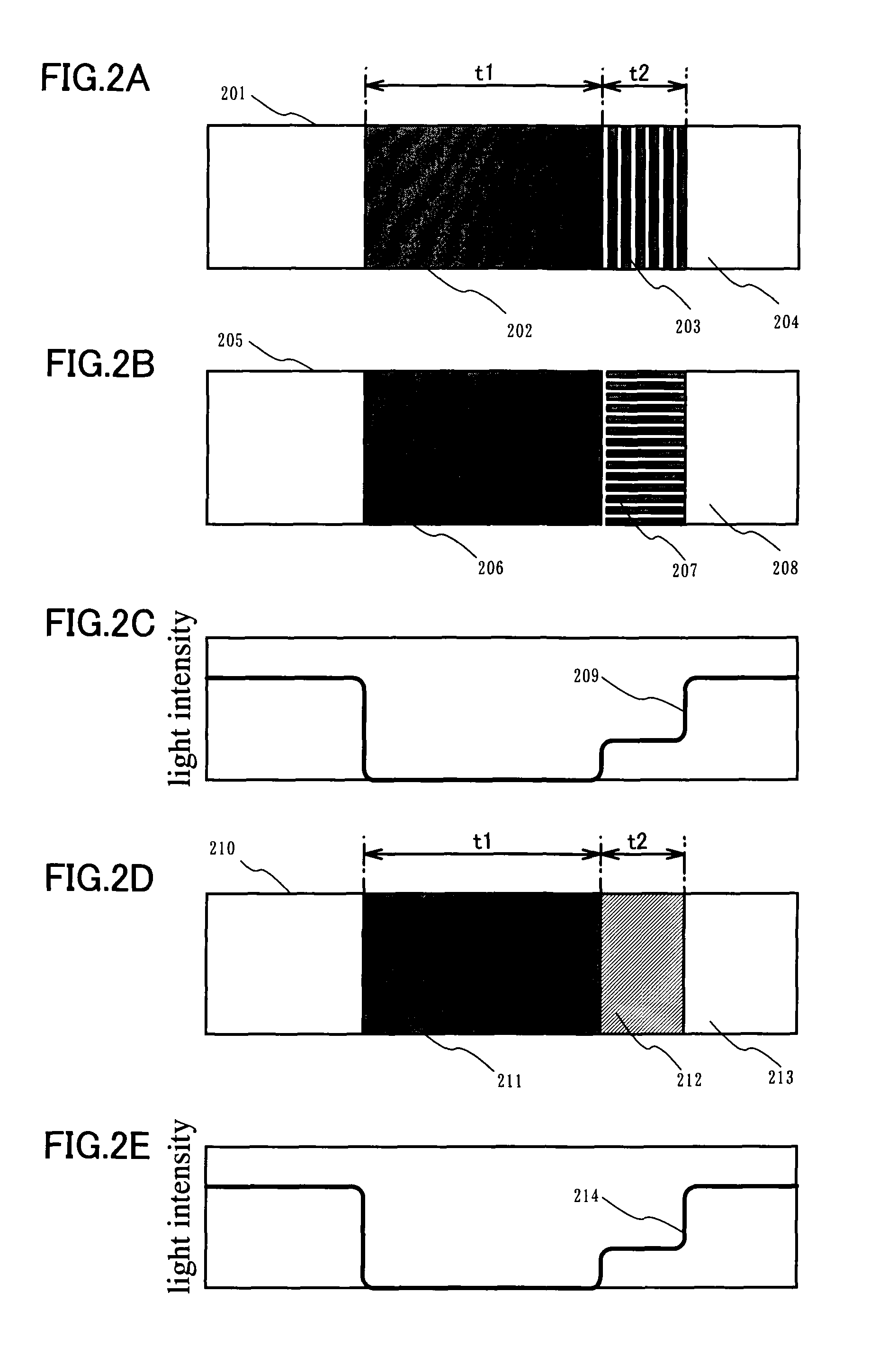Semiconductor device and manufacturing method thereof
a technology of semiconductor devices and manufacturing methods, applied in the direction of semiconductor devices, basic electric elements, electrical appliances, etc., can solve the problems of difficult formation of ldd regions having a width of 0.5 m or more in self-alignment manner, and achieve the effect of increasing the number of manufacturing steps, reducing parasitic capacitance or parasitic resistance, and high operational performan
- Summary
- Abstract
- Description
- Claims
- Application Information
AI Technical Summary
Benefits of technology
Problems solved by technology
Method used
Image
Examples
embodiment mode 1
[0055]This embodiment mode shows a step of forming a low-concentration impurity region in a self-alignment manner only on one side of a channel formation region by using a gate electrode of a TFT as a mask in ion-doping.
[0056]First, a first insulating film (a base insulating film) 102 is formed over a substrate 101 having an insulating surface. The substrate 101 having an insulating surface can be a light-transmitting substrate, for example, a glass substrate, a crystallized glass substrate, or a plastic substrate. When a thin film transistor that will be formed later is applied to a top emission light-emitting display device or a reflective liquid crystal display device, a ceramic substrate, a semiconductor substrate, a metal substrate, or the like can also be used.
[0057]The first insulating film 102 can be formed by using an insulating film such as a silicon oxide film, a silicon nitride film, or a silicon oxynitride (SiOxNy) film. Subsequently, a semiconductor layer 103 is formed...
embodiment mode 2
[0105]In this embodiment mode, an exposure mask provided with an assist pattern that is formed of a diffraction grating pattern or a semi-transmitting film and has a function of reducing light intensity, which is used in Embodiment Mode 1, will be explained with reference to FIGS. 2A to 2E.
[0106]It is to be noted that FIG. 1A shows a cross-sectional view of an exposure mask. Similarly, also in FIGS. 2A to 2E, a width of a light-shielding portion is referred to as t1, and a width of a portion provided with an assist pattern is referred to as t2.
[0107]As specific examples of the assist pattern, FIGS. 2A and 2B show part of top views of an exposure mask provided with a diffraction grating pattern having a slit portion formed of a line and a space, which are equal to or lower than a resolution limit of an exposure apparatus. A slit direction of the slit portion may be parallel to a direction of a main pattern (a light-shielding portion 202) like a slit portion 203, or may be perpendicul...
embodiment mode 3
[0113]A method for forming a conductive stacked pattern shown in Embodiment Mode 1 is not particularly limited. Here, an example of forming a conductive stacked pattern by changing etching conditions several times during the steps will be explained with reference to FIGS. 3A to 3F.
[0114]First, similarly to Embodiment Mode 1, a resist pattern 307a is formed over a second conductive layer 306a. FIG. 3A corresponds to FIG. 1B.
[0115]In FIG. 3A, over a substrate 301, a first insulating film (a base insulating film) 302, a semiconductor layer 303, a second insulating film (a gate insulating film) 304, a first conductive layer 305a, and the second conductive layer 306a are formed.
[0116]Then, as shown in FIG. 3B, etching is performed with a first etching condition using the resist pattern 307a as a mask to remove part of the second conductive layer, and thus, a second conductive layer 306b is formed. It is to be noted that the second conductive layer 306b is formed over the entire surface a...
PUM
 Login to View More
Login to View More Abstract
Description
Claims
Application Information
 Login to View More
Login to View More - R&D
- Intellectual Property
- Life Sciences
- Materials
- Tech Scout
- Unparalleled Data Quality
- Higher Quality Content
- 60% Fewer Hallucinations
Browse by: Latest US Patents, China's latest patents, Technical Efficacy Thesaurus, Application Domain, Technology Topic, Popular Technical Reports.
© 2025 PatSnap. All rights reserved.Legal|Privacy policy|Modern Slavery Act Transparency Statement|Sitemap|About US| Contact US: help@patsnap.com



